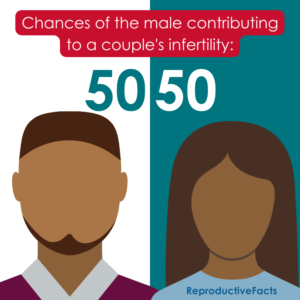Many people question a woman’s reasons for not getting pregnant. However, the pressure of getting pregnant isn’t only on women. It takes two to tango when it comes to fertility. According to a recent study, males account for approximately 50 percent of all infertility diagnoses.
What is a Male Infertility?
 The World Health Organization (WHO) describes male infertility as a man who has been unable to get a woman pregnant after a year of trying to conceive with frequent unprotected sex. To get a handle on male infertility, you first need to know how the male body works. The testicles produce sperm required to enter a woman’s egg. The roadmap that the sperm travels involves leaving the testes to enter a series of anatomy, known as the epididymis, vas deferens, ejaculatory duct, and finally, the urethra.
The World Health Organization (WHO) describes male infertility as a man who has been unable to get a woman pregnant after a year of trying to conceive with frequent unprotected sex. To get a handle on male infertility, you first need to know how the male body works. The testicles produce sperm required to enter a woman’s egg. The roadmap that the sperm travels involves leaving the testes to enter a series of anatomy, known as the epididymis, vas deferens, ejaculatory duct, and finally, the urethra.
Causes behind Infertility in Men
Understanding the reasons behind male infertility can be both challenging and emotional for couples hoping to conceive. It is important to identify the underlying causes of infertility, as this knowledge can guide you toward effective treatment options. Some potential causes to consider include:
Sperm Production Issues
- Low or an absence of sperm
- Abnormal sperm shape
- Poor motility or movement of the sperm
These problems can all result in the sperm not functioning correctly and not having the ability to travel to a woman’s egg.
Hormonal Imbalances
Male Anatomy

- The man may have an issue with the structure of his reproductive tract, causing the semen not to exit the body. A healthcare professional can observe these blockages in the ejaculatory ducts or seminal vesicles.
- Erectile dysfunction could stem from stress, anxiety, or multiple other factors.
- Injury to the testicles
Infections
Lifestyle/Environmental factors
- Smoking
- Excessive alcohol
- Obesity
- Environmental pollutants and toxins
How to get Diagnosed
Begin talking with your primary healthcare provider (PCP) to discuss getting a definitive diagnosis. The provider will start by completing a physical exam and ask questions about your sexual activity and health history.
Based on the exam and interview, the provider might order tests to determine the cause of the infertility. Possible tests would include:
- A semen analysis examines the semen itself, determining the amount and quality.
- Blood tests will analyze hormone levels and possible gene and chromosomal abnormalities.
- A urine test can detect sexually transmitted infections (STIs) as well as conditions such as diabetes.
- Scrotal or transrectal ultrasounds are non-invasive procedures that can identify structural problems or unknown blockages within the body.
- Testicular Biopsy is a minor procedure that will identify if the testicles are producing sperm incorrectly.
Depending on the results of these tests, your PCP may refer you to a urologist or reproductive endocrinologist for further evaluation and treatment.
How to Naturally Boost Sperm Count
- Get moving! Maintaining a healthy weight and moderate physical activity can increase those numbers.
- A healthy diet provides the body with antioxidants needed to produce sperm.
- Reducing stress will regulate hormonal levels that would block sperm production.
- Quitting smoking and reducing alcohol intake can enhance sperm quality, as clinical studies have shown that both can impair sperm function.
- Avoiding toxins like chemicals, lead, and pesticides by wearing proper protection when exposed.
- Beat the heat by staying away from hot tubs and saunas. Men should wear loose-fitting clothes and underwear. Increasing the testicles’ temperature can ultimately lower sperm quality.
Treatment Options
- Sexual intercourse counseling is a form of couple’s therapy that focuses on enhancing their sexual habits in the bedroom.
- Hormone treatments and medication help treat hormonal imbalances that could lower sperm production or assist in conditions like erectile dysfunction.
- Treat underlying infections or STIs through antibiotics to clear up the reproductive passageway.
- Surgical intervention can resolve issues within the structures or blockages within the body.
- Assisted reproductive technology (ART) involves the collection of sperm through natural ejaculation, which is then implanted into a woman’s uterus via intrauterine insemination, or it may include collecting eggs and sperm to create embryos for implantation in the uterus (in vitro fertilization).
Takeaways

During the first year of trying to conceive, embrace a healthy lifestyle, stay away from things that will decrease fertility, and have regular unprotected sex. After this timeline has ended, both men and women should consult their healthcare provider when they are ready to start a family to ensure a healthy conception and pregnancy. This conversation will give couples the guidance needed to begin their fertility journey.
Infertility can add stress and take an emotional toll on couples. Check out the Hopeful Mama Support Groups, where you can find a confidential and compassionate environment to explore and share your infertility experiences. Don’t navigate this journey alone—connect with others who truly understand!


 The World Health Organization (WHO) describes
The World Health Organization (WHO) describes 




